
A Trip down The Wabash in Old Postcards - Vincennes (2)
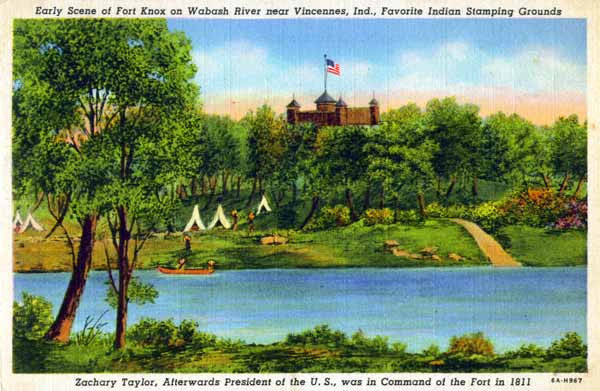
Early Scene of Fort Knox near Vincennes, Indiana, Favorite Indian Stamping Ground
Zachary Taylor, Afterwards Pewsident ofthe U. S., was in Command of the Fort in 1911
This unused linen postcard has the printed text...
6A-H967
A. A. Arnold, Vincennes, Ind.
Genuine Curteich Chicago "C. T. Art-Colortone" Post Card (Reg. U. S. Pat. Off.)
Fort Knox, established in 1788, was located
about three miles north of Vincennes over-
looking the Wabash River. Zachary Taylor
who became the 12th President of the United
States and died after serving only 16 months
in the White House was in command of Fort
Knox in 1811. General Jefferson Davis who
became president of the Confederacy married
Taylor's daughter. Fort Knox was the favorite
stamping grounds for many tribes of Indians,
including the Potawatomies, Miamis,
Chippewas, Ottowas, Delawares, Shawnees
Piankeshaws, Kickpoos and others.
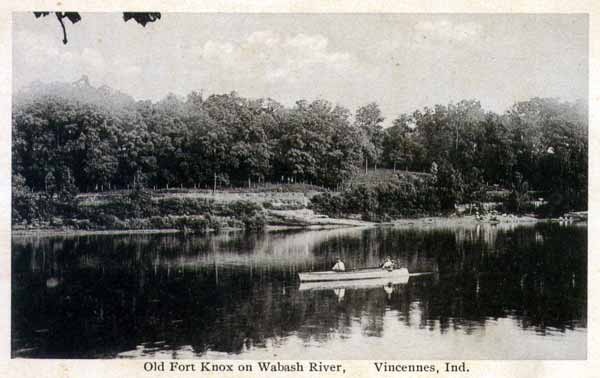
Old Fort Knox on theWabash River, Vincennes, Indiana
This unused postcard has the printed text...
H. H. Hamm. Toledo, Ohio
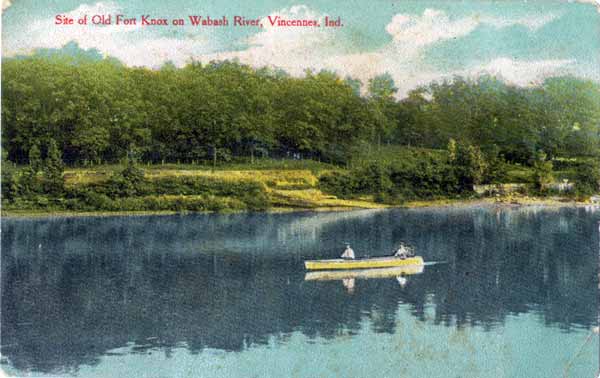
Site of Fort Knox on Wabash River, Vincennes, Ind.
This unused postcard has no other printed text.
There have been several forts at Vincennes. François-Marie Bissot, Sieur de Vincennes, a French Canadian explorer and soldier, acting under the authority of the French colony of Louisiana , constructed a fort in 1731. The outpost was designed to secure the lower Wabash Valley for France, mostly by strengthening ties with the Miami, Wea, and Piankashaw nations. It was renamed Fort Vincennes in honor of Vincennes, who was captured and burned at the stake during a war with the Chickasaw nation in 1735.
In 1736, Louis Groston de Bellerive de St. Ange assumed command of the post. He rebuilt the fort, turned the post into a major trading center, and recruited French traders to lure native peoples to settle there. By 1750, the Piankashaw resettled their village near the post.
British Lt. John Ramsey came to Vincennes in 1766. He took a census of the settlement, built up the fort, and renamed it Fort Sackville in honor of Lord George Sackville, who had led British forces to victory over the French in the Battle of Minden. The population grew quickly in the years that followed, creating a unique culture of interdependent Native Americans with French and British farmers, craftsmen, and traders.
After the American Revolution the government built a new fort, just up the street from the old one, and named it Fort Knox (usually referred to by local historians as Fort Knox I), after the US Secretary of War. During the relative peace with both the British and the Indians from 1787-1803, this was the western-most American military outpost.
There were problems between the garrison and townspeople of Vincennes. In 1796, the garrison was ordered not to venture beyond 100 yards of the fort. Territorial Governor William Henry Harrison petitioned the Secretary of War, Henry Dearborn, for money to build a new fort. In 1803, the federal government approved $200 to build a new fort, and the War Department bought land for the new fort north of Vincennes, at a landing about three miles up the Wabash river called Petit Rocher, which offered a good view up the river. This fort was also called Fort Knox, and referred to locally as Fort. Knox II. The sleepy little fort was famous mostly for duels (Captain Posey shot his second-in-command in 1811) and desertion. But by 1811 disagreements between Governor Harrison and Indian leader Tecumseh were reaching a head and captain, Zachary Taylor, was put in charge of the fort.
Source: Wikipedia
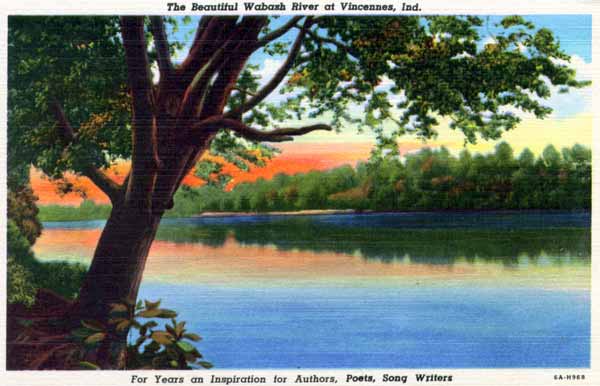
The Beautiful Wabash River at Vincennes, Indiana
This unused postcard has the printed text...
The Beautiful Wabash River at Vincennes, Indiana
For Years an Inspiration for Authors, Poets, Song Writers
6A-H968
A. A. Arnold, Vincennes, Ind.
Genuine Curteich Chicago "C. T. Art Colortone" Post Card (Reg. U. S. Pat. Off.)
Vincennes, Ind., The Famous Wabash
River at this point is more beautiful and
fascinating than anywhere in its 550 miles
course. Originally called "Ouabasche" by
the Indians which means "Here We Rest",
the river made possible the establishing of
the celebrated trading post here by Francis
Morgan de Vincennes who was later burned
at the stake by the Indians. The river here
divides the two great states of Indiana and
Illinois which are connected by a beautiful
bridge commemorating the crossing of the
river here by Abe Lincoln when he migrated
from Indiana to Illinois.
I have another copy of this postcard that was posted in Vincennes in 1949. It's interesting note that exactly the same photograph was used to illustrate a postcard of the Wabash at Terre Haute which was published by Wabash Valley News Agency Inc.
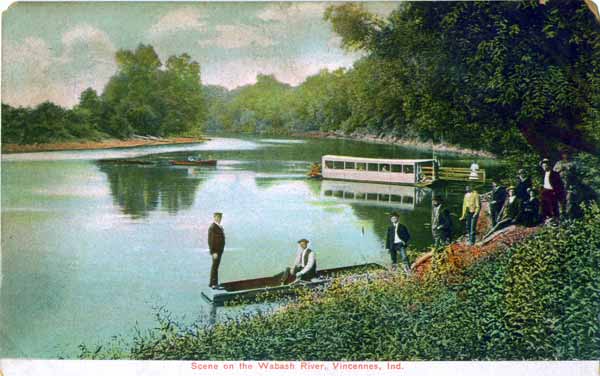
Scene on the Wabash River at Vincennes, Indiana
This postcard, posted in Vincennes on July 30th, 1907, has the printed text...
No. C637
Published by The American News Company, New York
Leipzig - Berlin
Germany
ANC NY Litho-Chrome Leipzig - Berlin - Dresden trademark logo
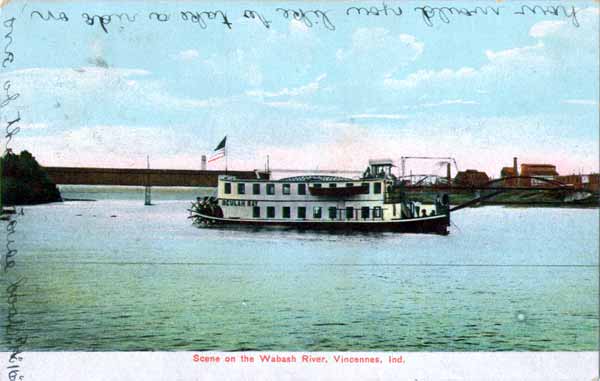
Wabash River, Vincennes, Indiana
This postcard, posted in Vincennes on March 29th, 1908, has the printed text...
No. C641
Published by The American News Company, New York
Leipzig - Berlin
Germany
ANC NY Litho-Chrome Leipzig - Berlin - Dresden trademark logo
The paddle boat featured in the photograph is the Beculah Ray
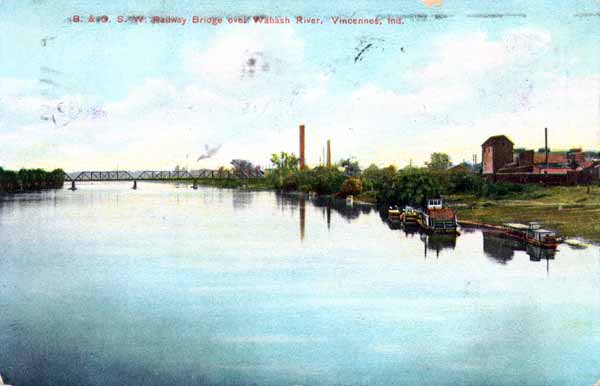
B. & O. S. W. Bridge over theWabash River, Vincennes, Indiana
This postcard, posted in Vincennes on August 25th, 1908, has the printed text...
No. C10073
Published by The Indiana News Company, Indianapolis, Ind.
Dresden - Leipzig - Berlin
Made in Germany
ANC NY Litho-Chrome Leipzig - Berlin - Dresden trademark logo
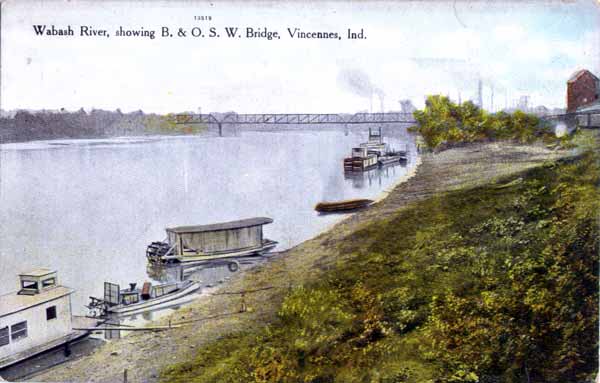
B. & O. S. W. Bridge over theWabash River, Vincennes, Indiana
This unused postcard has the printed text...
13519
Published by The Vincennes Capital, Vincennes, Ind.
Made in U. S. A.
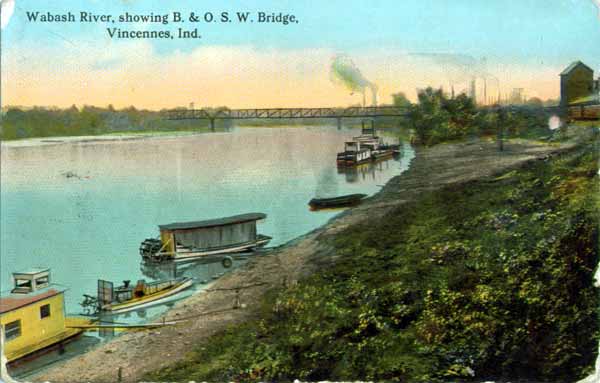
B. & O. S. W. Bridge over theWabash River, Vincennes, Indiana
This postcard, posted in Decker, Indiana on February 1st, 1915, has the printed text...
13519
W
The B & O refer to the Baltimore and Ohio railroad which was one of the oldest railroads in the United States. The rail road was chartered in Maryland on February 28th, 1827 and in Virginia on March 8th, 1827.
Source: Wikipedia
This page created 21st November 2009, last modified 4th March 2010